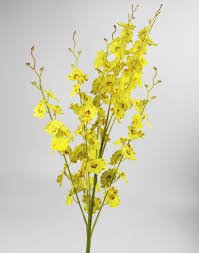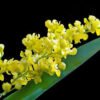# Ideal Fertilization Regimen for Dancing Lady Orchids (*Oncidium*)

Dancing Lady Orchids, scientifically known as *Oncidium*, are beloved among orchid enthusiasts for their striking beauty and unique flower shapes. However, to ensure their vibrant blooms and overall health, it is essential to provide them with an ideal fertilization regimen. This comprehensive guide will explore the various aspects of fertilizing *Oncidium* orchids, including nutrient requirements, types of fertilizers, application methods, and common challenges faced in orchid care.
## Understanding the Nutritional Needs of *Oncidium* Orchids
### Essential Nutrients for Orchid Growth
*Oncidium* orchids require a balanced supply of macronutrients and micronutrients to support their growth and flowering. These nutrients are categorized as follows:
#### 1. Macronutrients
– **Nitrogen (N):** Essential for promoting lush foliage and overall plant growth. It plays a crucial role in chlorophyll production, which is vital for photosynthesis.
– **Phosphorus (P):** Important for root development and flower formation. Phosphorus encourages blooming and enhances the quality of flowers.
– **Potassium (K):** Vital for water regulation, nutrient absorption, and overall plant vigor. It helps strengthen the plant’s structure and improves disease resistance.
These three macronutrients are often represented as N-P-K ratios on fertilizer packaging (e.g., 30-10-10), indicating the percentage of each nutrient.
#### 2. Micronutrients
While required in smaller quantities, micronutrients are equally important for orchid health. Key micronutrients include:
– **Calcium (Ca):** Supports cell wall structure and overall plant stability.
– **Magnesium (Mg):** Crucial for chlorophyll production and overall photosynthesis.
– **Iron (Fe):** Necessary for chlorophyll synthesis and preventing yellowing of leaves.
Other important micronutrients include manganese, zinc, and boron. A complete fertilizer should contain a balanced mix of these essential nutrients.
## Fertilization Requirements Throughout the Growth Cycle
### 1. Growth Phase
During the active growing phase, which typically occurs in spring and summer, *Oncidium* orchids require a higher nutrient supply. This phase is characterized by:
– **New Leaf Growth:** The orchid will produce new foliage, necessitating increased nitrogen levels.
– **Root Development:** The roots will grow and establish themselves, making phosphorus essential.
#### Fertilization Tips for the Growing Phase:
– **Frequency:** Fertilize every 2-4 weeks during the growing season.
– **Fertilizer Type:** Use a balanced, water-soluble orchid fertilizer with an N-P-K ratio of around 30-10-10 or 20-20-20. This ensures that the orchid receives adequate nutrients for vigorous growth.
### 2. Blooming Phase
As the blooming phase approaches, usually in late summer or early fall, the nutritional focus shifts:
– **Encouraging Blooms:** Phosphorus becomes crucial for promoting flower spikes and enhancing bloom quality.
– **Reducing Nitrogen:** Too much nitrogen during this phase can lead to excessive foliage growth at the expense of blooms.
#### Fertilization Tips for the Blooming Phase:
– **Frequency:** Transition to fertilizing every 4-6 weeks as buds begin to form.
– **Fertilizer Type:** Use a fertilizer higher in phosphorus, such as a ratio of 10-30-20. This promotes blooming while still providing essential nutrients.
### 3. Dormant Phase
During the dormant phase, typically in fall and winter, the orchid’s growth slows down, and its nutrient requirements decrease significantly:
– **Minimal Nutrient Needs:** Orchids require fewer nutrients during this period.
#### Fertilization Tips for the Dormant Phase:
– **Frequency:** Fertilize sparingly, about every 6-8 weeks, or consider omitting fertilizer altogether if the orchid is in a cool, low-light environment.
– **Fertilizer Type:** Use a diluted, balanced fertilizer at a lower concentration to avoid over-fertilizing.
## Types of Fertilizers for *Oncidium* Orchids
Selecting the right type of fertilizer is critical for promoting healthy growth and vibrant blooms. Here are some common types of fertilizers suitable for *Oncidium* orchids:
### 1. Water-Soluble Fertilizers
Water-soluble fertilizers are popular among orchid growers due to their ease of use and fast-acting nature. They dissolve in water and can be applied during regular watering.
#### Recommended Products:
– **Balanced Fertilizers:** A balanced formula, such as 20-20-20, is ideal during the growing phase.
– **Bloom Boosters:** Formulations like 10-30-20 can be used during the blooming phase to enhance flower production.
### 2. Slow-Release Fertilizers
Slow-release fertilizers gradually release nutrients over time, reducing the frequency of application. These fertilizers are typically mixed into the potting medium.
#### Recommended Products:
– **Granular Formulas:** Slow-release granules with a balanced N-P-K ratio can be beneficial for long-term feeding.
### 3. Organic Fertilizers
Organic fertilizers, such as fish emulsion, seaweed extract, or compost, provide a natural alternative for nourishing *Oncidium* orchids. These fertilizers improve soil health and enhance microbial activity.
#### Recommended Products:
– **Fish Emulsion:** Rich in nitrogen and micronutrients, fish emulsion can promote foliage growth.
– **Seaweed Extract:** Provides trace minerals and hormones that can enhance root development and flowering.
### 4. Fertilizer Spikes
Fertilizer spikes are solid fertilizers that are inserted into the potting medium. They provide a slow release of nutrients over several weeks.
#### Recommended Products:
– **Orchid Fertilizer Spikes:** These are specifically formulated for orchids and can be a convenient option for providing nutrients over time.
## Application Methods
### 1. Dilution and Mixing
Most water-soluble fertilizers require dilution before application. Follow these steps:
– **Read the Label:** Check the manufacturer’s instructions for the recommended dilution rate.
– **Mix with Water:** In a separate container, mix the appropriate amount of fertilizer with water.
### 2. Watering Technique
The application method is just as important as the fertilizer used:
– **Watering:** Water your orchid thoroughly before applying fertilizer to prevent root burn. Apply the diluted fertilizer solution while the plant is actively growing.
– **Avoiding Foliage:** Focus on watering the potting medium, avoiding excessive fertilizer on leaves or flowers to prevent damage.
### 3. Frequency of Application
Establishing a regular fertilization schedule is crucial for successful orchid care:
– **Growing Phase:** Fertilize every 2-4 weeks, depending on the type of fertilizer used.
– **Blooming Phase:** Switch to every 4-6 weeks with a focus on phosphorus.
– **Dormant Phase:** Reduce frequency to every 6-8 weeks or skip if the plant is not actively growing.
### 4. Foliar Feeding
Foliar feeding involves spraying diluted fertilizer directly onto the leaves. This method allows for quick nutrient absorption and can be beneficial during the growing phase.
#### Steps for Foliar Feeding:
1. **Dilute Fertilizer:** Mix a diluted solution of water-soluble fertilizer.
2. **Spray Leaves:** Lightly mist the leaves, avoiding flowers and the potting medium.
3. **Timing:** Perform foliar feeding in the early morning or late afternoon to prevent leaf burn.
## Monitoring Orchid Health and Adjusting Fertilization
### 1. Observing Growth and Health
Regularly monitor your *Oncidium* orchids for signs of nutrient deficiencies or excesses:
– **Yellowing Leaves:** May indicate nitrogen deficiency.
– **Stunted Growth:** Could signify a lack of essential nutrients.
– **Burnt Leaf Tips:** Often a sign of over-fertilization or salt buildup.
### 2. Adjusting Fertilization Based on Growth Response
Based on your observations, you may need to adjust your fertilization regimen:
– **Increase Fertilization:** If growth is slow or foliage appears pale, consider increasing the frequency or concentration of fertilizer.
– **Decrease Fertilization:** If leaf tips are burning or growth appears too lush with little flowering, reduce the frequency and switch to a lower nitrogen formula.
## Common Challenges in Fertilizing *Oncidium* Orchids
### 1. Over-Fertilization
Over-fertilization can lead to nutrient burn and root damage. Signs include:
– **Brown Leaf Tips:** Indicate nutrient burn caused by excess salts.
– **Root Rot:** Overly concentrated fertilizers can damage roots, leading to rot.
#### Solutions:
– **Flush the Potting Medium:** Water thoroughly to leach out excess salts. Use plain water without fertilizer to help reset the nutrient levels.
– **Repotting:** If severe root damage occurs, consider repotting in fresh potting medium to promote recovery.
### 2. Under-Fertilization
Under-fertilization can stunt growth and reduce blooming:
– **Lack of Blooms:** Indicates insufficient phosphorus for flowering.
– **Pale Leaves:** Suggest a lack of nitrogen for foliage growth.
#### Solutions:
– **Increase Fertilization:** Adjust your regimen to include more frequent applications during the active growing season.
– **Balanced Nutrition:** Ensure a balanced supply of nutrients by using a complete fertilizer with essential micronutrients.
### 3. Environmental Factors
Environmental conditions can affect nutrient uptake:
– **Temperature and Humidity:** High temperatures and low humidity can increase water stress, impacting nutrient absorption.
#### Solutions:
– **Monitor Conditions:** Adjust watering and fertilization schedules based on environmental changes.
– **Maintain Humidity:** Use humidity trays or misting to keep humidity levels suitable for your orchids.
## Conclusion
A well-planned fertilization regimen is crucial for the health and beauty of Dancing Lady Orchids (*Oncid
ium*). By understanding their nutritional needs throughout different growth phases, selecting the right fertilizers, and applying them correctly, you can ensure that your orchids thrive and produce stunning blooms year after year. Regular monitoring and adjusting of your fertilization practices will further enhance your ability to grow these exquisite orchids successfully. With the right care, your *Oncidium* orchids can be a spectacular display of nature’s artistry.

